


This weekend's big movie release is F1, the likely summer blockbuster produced by Jerry Bruckheimer, directed by Joseph Kosinski (Top Gun: Maverick) and starring Brad Pitt as a washed-up race car driver given one last chance. Set in the world of Formula One racing and shot on actual tracks during race weekends with real drivers in cameo roles, its screenplay was called "formulaic to the point that it's almost parodic" by UK critic Mark Kermode.
"Do not go in expecting complex storytelling," Kermode warns, and says that Pitt – "a movie star in the mode of Steve McQueen" – is ultimately why it works: "It's Brad Pitt goes fast and then smiles at you in a cheeky way." Manola Dargis at the New York Times also couldn't resist some punning with the movie's name, saying "the story is as formulaic as its title subject."
"A great deal depends on your love of or maybe just tolerance for straightforward, ostentatious, professionally crafted spectacles that don't ask much of you but time and money," Dargis writes, but this is a summer film and we are talking about Brad Pitt and since the picture doesn't need to win over hardcore Formula One fans as much as ticket buyers looking for spectacle and star power, I'd give it a more than even chance of walking away with a good chunk of summer box office.
We get a movie about motorsport two or three times a decade. The most recent were the biopic Ferrari and the gamer-drives-a-race-car pic Gran Turismo (both in 2023), preceded by Ford V Ferrari (2019), Rush (2013) and Talladega Nights (2006), a comedy that was embraced with both arms by NASCAR, it's satiric subject.
The decades before that are littered with star-powered motorsport pictures, either parked or smoking – titles like Days of Thunder, Stroker Ace, Bobby Deerfield, The Last American Hero and Winning. Steve McQueen's passion project Le Mans (1971) is the noble bomb that every racing fan has seen more than once, but the film that looms over them all is the first great big-budget race car picture, John Frankenheimer's Grand Prix (1966).
Kosinski's movie was made because of the sudden spike in popularity of Formula One thanks to the hit Netflix reality series Drive to Survive; Frankenheimer's picture came about when motorsport's pinnacle racing series had its first big flush of publicity and international appeal, when the world noticed it had the easily packaged glamour, aspirational appeal and drama that stock cars, drag racing, rallying and endurance racing lacked in comparable ratios.
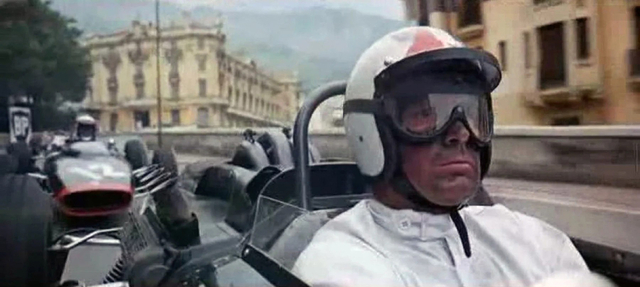
Grand Prix begins in Monaco, the only street race circuit left on the Formula One calendar in the mid-'60s, and still its most glamourous track, winding up and down the steep old streets of the municipality and past the yachts in the harbour. The credit sequence is the work of legendary designer Saul Bass: a series of detailed close-ups of the cars and their drivers spawn across the screen into bars and grids that, like the super wide angle cameras mounted on the race cars, was meant to maximize the Cinerama film format (much as Kosinski's film uses IMAX cameras to tempt moviegoers into the premium cinema experience instead of waiting for F1 to stream on Apple+).
The first thing that Drive to Survive fans might notice about Monaco in 1966 is how unprotected the streets and the spectators are from the cars racing at top speed. Pedestrians dart out onto sidewalks mere feet from the open track and hay bales at corners seem to comprise the whole of track safety. Today the track at Monaco – like every other racetrack – is lined with steep fences with high concrete foundations, Armco barriers and deep tire walls at the corners to cushion crashes.
When I photographed IndyCar races for several years every practice and race day began early with a mandatory safety meeting where we were threatened with ejection from the race and a ban from the series if we broke any of the stringent rules that allowed us to be close to the track fences. Today the only racing series that lets fans crowd close to roads where cars run rallying, and surprisingly the only spectator fatality in the World Rally Championship since the start of this century, was in 2017 in Monte Carlo. (By comparison three WRC drivers have died since 2000.)
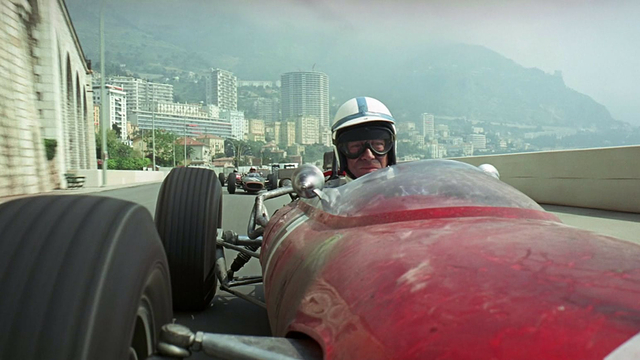
In The Limit: Life and Death on the 1961 Grand Prix Circuit, Michael Cannell's superb book about Formula One's most dangerous years, he notes that Monaco was where "the smallest slip could send a car into a storefront or streetlamp. Pedestrians stood unprotected on the curb, almost within reach of passing cars. Six years earlier Alberto Ascari had driven his Lancia into the harbor, and a driver once missed a sharp left turn and rammed his hood into the ticket office of the train station."
The obvious danger is only the greatest of the challenges that face the four drivers at the centre of Frankenheimer's story, who we meet on the starting grid at Monaco. There's Sarti (Yves Montand), a three-time champion racing for Ferrari and his young teammate Barlini (Antonio Sabato). Nipping at Sarti's heels are the American Pete Aron (James Garner) and Scott Stoddart (Brian Bedford), both teammates at Jordan BRM, a British team.
They're all at the front of the pack racing around Monaco; the track is infamous for its lack of passing so the finish line usually resembles the starting grid unless someone makes a mistake or has an accident. Which is what happens when Pete has gearbox trouble that slows down Stoddart; the two cars make contact going into a corner, sending Pete into the harbor like Ascari while Stoddart totals his car when it collides with one of the steep cliff walls on the other side of the road.
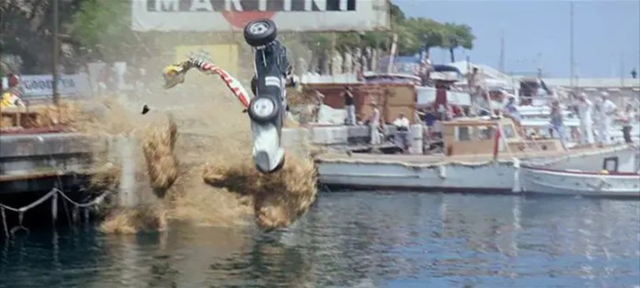
Sarti wins the race, Stoddart ends up in the hospital and Pete is fired by the team owner (Jack Watson). The scenes that follow introduce the rather somber melodrama that makes up most of the picture that doesn't take place on the track. There's Stoddart's dishy American wife Pat (Jessica Walter), who's tired of the circuit and what she considers her husband's death wish. This pushes her into the path of Pete, who temporarily has to cool his heels doing color race commentary for an American TV network while looking for another seat in a car.
Sarti meets Louise (Eva Marie Saint), an American journalist putting together a Formula One feature for a fashion magazine, at the parties after his Monaco win. He has already intimated to Pete that he's getting tired of racing, but his budding romance with Louise gives him a chance at distraction and the opportunity to show her around his world, which is meant to look like it's full of Old World glamour in the movie, but is nowhere near as slick, cash rich and international as Formula One has become today.
Pete disapproves of Pat for leaving her bedridden husband when he needs her the most, while Pat disapproves of Pete for wanting to get involved with a woman like her; everything we need to know about their relationship is the scene where he ignores her wordless suggestion to join her in her hotel room, but waits with smug patience at the door of his, just down the hall, knowing that she'll accept the invitation. Young people might have been shocked at adults pursuing a relationship based in no small part on contempt, but Grand Prix is the sort of movie, made at the kind of time, when it was very sophisticated to admit these things happened.
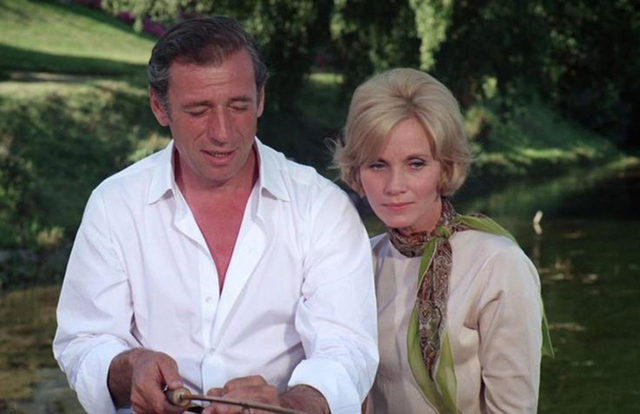
In the meantime, Sarti's impetuous teammate Barlini meets Lisa (French chanteuse Francoise Hardy) at the kind of youthful establishment where kids frug to beat music that sounds a bit too much like "Yakety Sax" (a low point in composer Maurice Jarre's soundtrack). They begin a relationship that, thanks to Sabato and Hardy's mutual lack of acting talent, makes the couple seem either callow or comic, though pretty much how young people looked in Hollywood films even as the first tremors of the youthquake were being felt.
Pete's a pretty bad TV presenter so he keeps looking for a seat, going so far as to travel to Ferrari's factory in Maranello to plead with Manetta (Adolfo Celi), the owner, for his old place back, at a discount. Ferrari's participation in Grand Prix was conditional but nobody would have been fooled that Manetta was anyone but Enzo Ferrari. Celi, in Enzo's trademark dark suits and shades, plays him like a Bond villain, manipulative and quietly threatening, which was hardly a stretch after his role as Largo in Thunderball just a year previous.
Pete has better luck with Izo Yamura (Toshiro Mifune, voiced by Paul Frees), the head of a massive Japanese keiretsu whose automotive division is running a Formula One team that's stuck in last place. (Honda entered Formula One as a constructor from 1964 to 1968.) He offers Pete a place on the grid in an unprecedented third team car, and the two men develop a quick mutual respect that's cemented when Pete merely shrugs after Yamura admits to shooting down several American planes during the war. Garner actually has more onscreen chemistry with Mifune than he does with Walters.
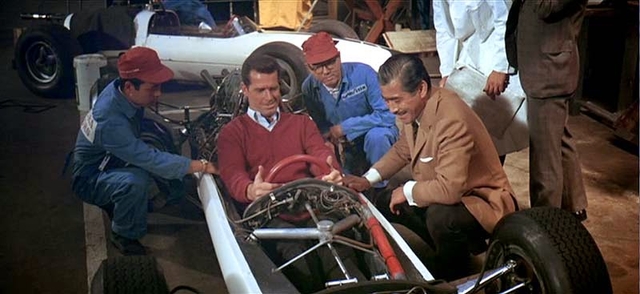
In Pete and Stoddart's absence, the Ferrari drivers dominate the season, but Pete proves competitive in the Yamura car while Stoddart is determined to recover enough to get back on track. We see him return home to his parents' country house, a shrine to his older brother, a celebrated driver who was killed on the track just a couple years before. Bedford's Stoddart wears a tartan band on his helmet that suggests the character is based on Jackie Stewart, but while Stoddart is very posh and Home Counties Stewart was solidly middle class and Scottish, the only other thing they have in common is the dishy wife.
The film progresses through the largely European circuits of the '60s – to the French Grand Prix at Clermont-Ferrand, the Belgian Grand Prix at Spa, the Dutch Grand Prix at Zandvoort and the British Grand Prix at Brands Hatch. (The North American races in Mexico and at Watkins Glen happen conspicuously offscreen.) Frankenheimer depicts each race with a different mood – Clermont-Ferrand is romantic and dreamlike as Sarti and Louise fall in love, the race at Spa rigid and technical, and Bass provides montages to match, his grids blooming over the screen, overwhelming us with closeups and camera angles that either sail over the circuit or hug the track.
What we also get to see is a lot of real Formula One drivers; Phil Hill, a former Ferrari driver and 1961 World Champion, drove the modified camera car at Monaco and Spa, while the grid is filled with drivers like Bruce McLaren, Jo Siffert, Graham Hill, Juan Manuel Fangio, Dan Gurney, Jochen Rindt, Jack Brabham, Richie Ginther, Jim Clark, Lorenzo Bandini, Joakim Bonnier, Bob Bondurant and Ludovico Scarfiotti. Most of them appear in a scene at Spa where Sarti tries to lead a drivers' revolt against the appalling safety conditions at the weather-prone track.
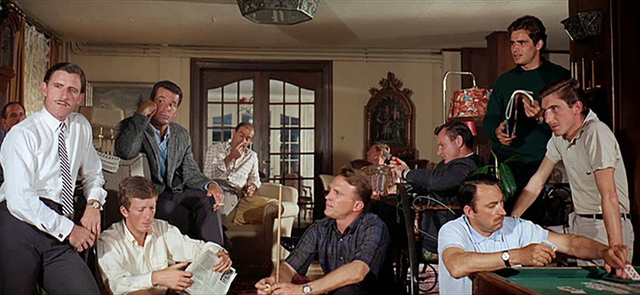
These kind of protests happened all the time in racing against stiff opposition from race authorities, fans and even other drivers. Because Formula One, and automobile racing in general, were fantastically deadly pretty much from its inception and especially once Formula One reestablished itself in its modern incarnation after World War Two.
The blackest single day in motorsport was the notorious 1955 Le Mans race, where an accident by the entrance to the pits in front of the starting line grandstands launched the Mercedes-Benz of Pierre Levegh end over end off the track and into the crowd. It spun for eighty-five yards, hitting a dirt barrier and then a concrete stanchion that took the car apart.
"The hood spun loose and sliced through the crowd like a giant scythe," Cannell writes in The Limit, "decapitating a row of spectators. The engine, suspension and brakes followed in a hundred parts. A fireball of burning gasoline sprayed through the scene. Entire families died in a second. A woman awoke from unconsciousness to find herself lying under a pile of bodies. Fifty yards from the grandstand a girl screamed when a severed foot hit her."
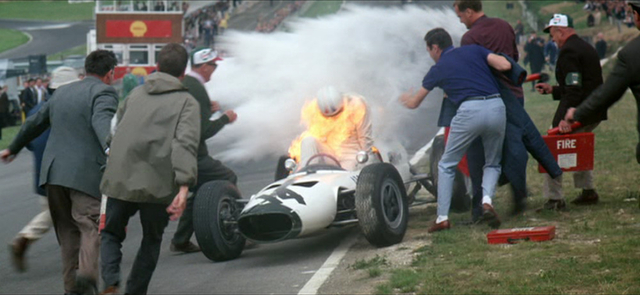
Deaths on the Formula One track started in 1952 with Cameron Earl during a test, and only 1956 passed without a single fatality. There were three in 1955, four in 1958, and three each in 1960 and 1961. 1963 and 1965 were free of deaths on track, but of the men who appeared onscreen in Grand Prix, Bandini would die at Monaco in 1967, Rindt at Monza in 1970 and Siffert in 1971 at Brands Hatch. Improvements in safety that drivers like Jackie Stewart fought bitterly for, both on the track and in the cars, meant that only 19 drivers have died in Formula One cars in over five decades, the most famous being Ayrton Senna in 1994 and the last being Jules Bianchi at the Japanese Grand Prix in 2014. Grim, but an improvement over the 31 who died in the sport's first 20 years.
Safety has improved in other motorsports as well but the danger never goes away; the last NASCAR death was Dale Earnhardt at the Daytona 500 in 2001, the last Le Mans fatality was Allan Simonsen in 2013, and the last IndyCar death was Justin Wilson at Pocono in 2015 – a driver who was once kind enough to talk me through the challenges of racing my hometown street circuit in Toronto.
Spectacular crashes and the potential deaths of drivers were so much a part of Formula One in the '60s that Frankenheimer and MGM had the full cooperation of the sport's organizing bodies, its teams and drivers, knowing full well that an onscreen death would be featured in the picture. Sabato's Barlini is the only one of the quartet of drivers who seems blithely accepting of the risks, while Pete, Stoddart and especially Sarti visibly struggle with the potential cost of their career – so much that the audience is certain from the moment Bass' credits roll that at least one of them will be dead by the end of the picture.
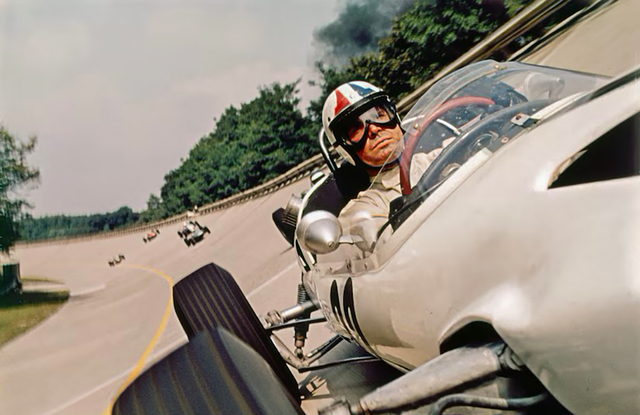
And we're sure it'll happen at the climactic Italian Grand Prix at Monza, after the picture loads on the foreboding. All the characters are forced to make decisions before the race – Pat about returning to Stoddart, Sarti about leaving his loveless marriage to his heiress wife (Genevieve Page) for Louise, and Barlini about whether two Japanese girls are worth more than Hardy's Lisa, who has decided in any case to go wreck diving in Greece with a Vespa-riding American boy.
The choice of Monza is notable, first because it pulls Sarti closer into the orbit of Manetta and the Ferrari factory, the second because even among '60s racetracks it was particularly dramatic and dangerous. The third oldest purpose-build circuit in the world and the oldest in Europe, its signature feature was the steeply banked oval; taken at full speed the centrifugal force pushes the car's suspension down so much that every bump on the rough surface travels through the bottom of the car to the driver's spine.
As the drivers prepare the camera zooms in on the bracelets they wear with their names and blood types. All four men are in contention for the championship with just three points separating them. An exhaust pipe falls off Stoddart's car as Sarti trails him on the banking and sends the Frenchman careening off the track, his car exploding into a fireball as it lands on the stretch of track that passes underneath the banking, echoing the crash that killed Phil Hill's Ferrari teammate Wolfgang von Trips at Monza in 1961.

Grand Prix was made as the debate about how dangerous a sport like racing should be was meeting opposition that defended the risks as an essential element to motorsport's history and appeal. Charles Jennings writes in Burning Rubber, his history of Formula One, that "men in rally jackets, who would go to their graves without ever competing in a motor race of any kind, nonetheless felt entitled to disparage (Jackie) Stewart and his safety campaign as if the whole point of the sport was to stand a good chance of dying an unnecessary and painful death. In their world, the ethos of motor racing entailed, not a love of living on the edge, but a deathwish, and any attempt to lower the risk were somehow contrary to the sport's fundamentals."
Which is why the film climaxes with the operatic moment where Sarti's wife leaves the track in the ambulance with his body, leaving Louise behind to confront the press photographers (always the most visible face of media callousness) with her hands covered in the driver's blood, screaming at them that this is what they wanted. And why it ends soberly a few moments later after Pete, the winner of the race and the championship, is left alone at the finish line as the sun sets to contemplate his pyrrhic victory.
Jackie Stewart would ultimately be successful at shaming motorsport into making racing safer not just for drivers but for spectators – his cunning move, according to Jennings, as it made safety more attractive to promoters who carried the biggest liabilities. But he left racing abruptly in 1973 after the death of his friend and teammate Francois Cevert at the US Grand Prix at Watkins Glen. Today the banked curve at Monza sits abandoned behind a row of grandstands.
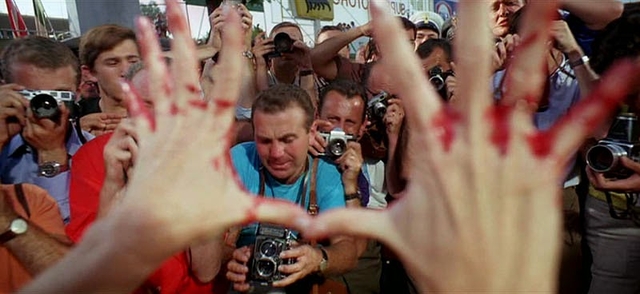
Nobody wants to return to the bloody days of motor racing, but it's hard not to watch Grand Prix as a motorsport fan without nostalgia. The tracks are unsafe, to be sure, but the crowds look so much more proletarian at a time when a ticket to Sunday at the Monaco Grand Prix starts at €2340. Drive to Survive and Netflix has brought growth back to F1, but it's also driven ticket prices up exponentially.
And then there are the cars – small, sleek and iconic, their braided exhaust pipes trailing from the back of the cigar shaped bodies with their chromed suspension struts and spoked wheels. In a few years they'd become flatter and broader and ultimately bigger, as wings and aero packages expressed themselves in carbon fibre to wring more crucial downforce from each lap. They also created more salable billboard space as corporate sponsorship brought real money into Formula One – the kind of money that created the world where F1 the movie is set.
Grand Prix is a snapshot of racing when the wives, girlfriends and mistresses of drivers sat in folding chairs on pit lane with stop watches and clipboards recording lap times, mechanics looked like mechanics and garages looked like garages, all flaked paint on scarred bricks and oil-stained concrete. There were no hospitality suites or PR handlers for each driver. Engines roared instead of buzzed and none of the heat was recovered with computerized braking systems. It's a world I never lived through and Grand Prix makes me feel guilty for being nostalgic about such a terrible, dangerous place.
Club members can let Rick know what they think by logging in and sharing in the comments below, as access to the comments section is one of many benefits that comes along with membership in the Mark Steyn Club.
